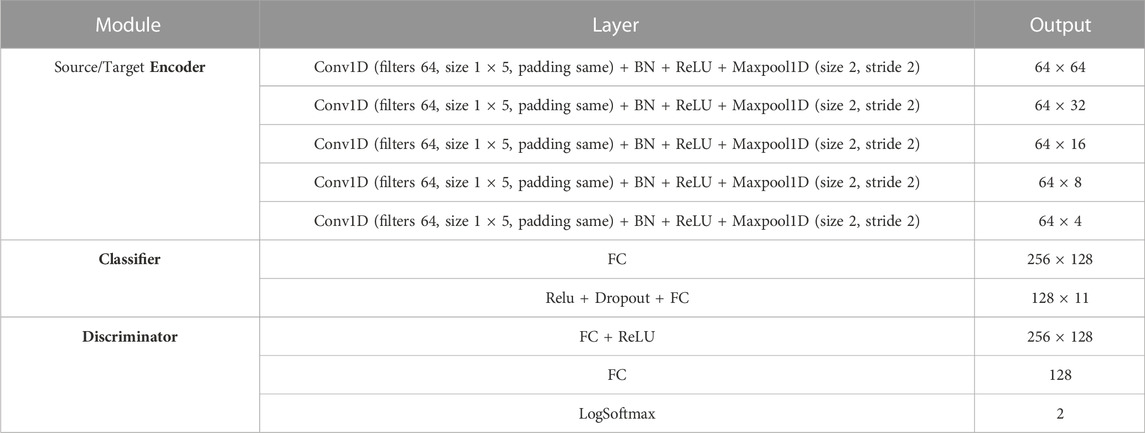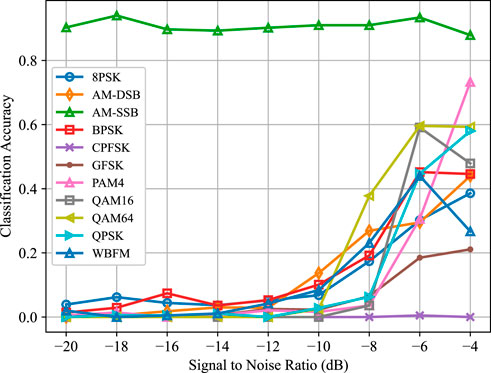- School of Information and Communication Engineering, Beijing University of Posts and Telecommunications, Beijing, China
Dramatic advances in wireless networks have led to the Smart IoT, which may enable new modes of information transfer. Generally, data-driven advanced artificial intelligence (AI) techniques can be used in smart IoT networks, which prones to a lot of unexpected challenges. Enabling efficient management of spectrum resources based on cognitive radio is considered to be an effective means to address the limited spectrum resources. As a key technology in CR, automatic modulation recognition (AMR) is developing towards intelligence with deep learning as the main approach. Deep learning (DL) has been widely applied to AMR for possible improvement of recognition accuracy, while the superb performance highly depends on high-quality and well-labeled datasets. Consequently, these requirements prone to poor performance in the environments where the datasets are not well-labeled. Motivated by this, domain adaptation is considered for AMR in this paper, and a novel network architecture is proposed therein, termed semi-supervised automatic modulation recognition (SemiAMR). Specifically, source domain high SNR data are mapped by the source encoder to the classification domain and classified by the classifier, where the source data with labels enable this training process. Next, the discriminator and the target domain encoder are trained by determining whether the data is from the target or source domain. Finally, the target domain encoder and classifier are combined and are used to infer the data labels of the target domain. Experimental results state that the accuracy of proposed SemiAMR achieves 1\% to 27\% improvements when compared with classical schemes under the target domain condition where there is no corresponding labeled data and signal-to-noise ratios (SNRs) varies from −20 dB to −4 dB.
1 Introduction
With the continuous evolution of next-generation communication technology, multi-band, ultra-broadband, high frequency, and internet of everything (IoX) seem the main direction of attention, prone to the extremely complex wireless environment and fine-grained multi-dimensional network resources [1–3]. In this context, traditional model-driven wireless communication is inapplicable due to the exponential growth of wireless terminals and increasing communication overhead. On the contrary, data-driven model, such as artificial intelligence (AI), etc. [4, 5], brings new impetus to wireless communication, relying on its powerful capacity of feature learning. As a key technology of wireless communication, automatic modulation recognition (AMR) is facing new opportunities and potential with the assistance of AI [6].
Typically, traditional AMR schemes mainly contain likelihood-based (LB) scheme [7, 8] and feature-based (FB) scheme [9]. The modulation modes are determined by likelihood value for LB while the features of FB are pre-designed by experts and leveraged to infer the accurate label. However, both LB and FB are well-designed and low-robust, resulting in limited accuracy. Recently, deep learning (DL) is widely applied to AMR, processing the baseband signal intelligently and extracting the valuable feature automatically [10, 11]. Z. Zhang et al; [12] proposed a CNN-LSTM dual-stream structure to implement AMR, which leveraged the temporal in-phase/quadrature and amplitude/phase feature. S. Huang et al; [13] proposed a novel grid constellation matrix (GCM)-based AMC method using a contrastive fully convolutional network (CFCN), which brought promising classification performance and better robustness. However, the aforementioned AMR schemes are driven by abundant training data and large-scale parameters [, 14, 6]. To collect a rich dataset with accurate labeling seems a difficult task in the practical scenarios, limiting the performance of DL-based AMR schemes.
To solve the issue of insufficient samples, K. Bu et al. [15] proposed an adversarial transfer learning-based AMC, named ATLA, with half of the training data reduced, and the target model achieved competitive recognition accuracy by supervised learning. Besides, L. Li et al. [16] proposed a capsule network-based AMC architecture (CapsNet), which leveraged 3% of the dataset for training and obtained 80% classification accuracy. However, both ATLA and CapsNet do not work under the target domain without corresponding labeled training data. Recognizing modulation modes at low SNRs poses a challenge because the reduced SNR degrades the quality of the transmitted signal, making recognition more difficult. Methods to cope with this problem include enhancing the SNR, optimizing receiver parameters, adopting a multi-mode approach, and using advanced recognition algorithms [17]. In fact, modulation mode recognition under low SNR conditions is a complex task that requires consideration of multiple factors.
In this paper, inspired by adversarial learning, we design a semi-supervised automatic modulation recognition network (SemiAMR) to implement cross-domain recognition, which can adapt to another signal-to-noise domain with no corresponding labeled data pre-trained. In detail, the source domain is mapped into the classification domain by the source encoder and can be classified by the classifier, where the labeled source data enables the process. Then, the discriminator and target encoder are trained by determining whether the data comes from the target or source domain. Finally, the target encoder and the classifier are leveraged to infer target domain data labels. The contributions and main work of this paper can be summarized as follows.
1. A novel network is proposed to implement semi-supervised learning for AMR, which consists of two CNN-based encoders, a classifier, and a domain discriminator.
2. To enable the inference ability of the DL-based model on target data, all domain data are mapped into a classification domain. The source encoder enables the source data into the classification domain. The target domain data is employed by the target encoder, which is trained by an adversarial distinguish process.
3. Extensive experiments are carried out to validate the performance of the proposed scheme under the target domain. Under the poor signal-to-noise environment, the results elaborate that the proposed SemiAMR improves the classification accuracy from 3% to 27% for the target domain, compared with no adaptation algorithm.
The rest of this paper is organized as follows. Section 2 discusses related work of this paper including semi-supervised learning, spectrum monitoring and automatic modulation classification. In Section 3, the signal model wireless signal and motivation are firstly provided. Section 4 mainly considers the proposed semi-supervised scheme for wireless IoT. Experiment and discussions are implemented in Section 5. Finally, the conclusion of this paper is described in Section 6.2 Related work
This section gives a brief introduction of existing methods on semi-supervised learning, spectrum monitoring, and automatic modulation classification.
2.1 Semi-supervised learning
The problem of limited labeled data is a major challenge in training DL-based models [18]. Semi-supervised learning aims to address this challenge by utilizing the information contained in unlabeled data to improve the performance of models. Semi-supervised learning has broad applications in various fields, including image classification, text classification, speech recognition (SR), computer vision (CV), and natural language processing (NLP). There are various approaches to semi-supervised learning, including graph-based semi-supervised learning [19], generative semi-supervised learning [20], and semi-supervised support vector machines [21]. Each approach has its own strengths and weaknesses, and the choice of approach depends on the specific problem being addressed.
Graph-based semi-supervised learning uses the graph structure in unlabeled data to build a model. The method utilizes a technique called graph embedding, which maps nodes in the graph into a low-dimensional space. By mapping nodes into a low-dimensional space, we can better understand the relationships between nodes. In graph-based semi-supervised learning, we can use these relationships to infer the labels of unlabeled data. Generative semi-supervised learning methods are based on generative models that generate data distributions from unlabeled data. The method uses the generative model to estimate the distribution of the unlabeled data and uses this distribution to make predictions. Generative semi-supervised learning methods are a very effective method, especially when the amount of data is small.
Semi-supervised support vector machine is a supervised learning method based on kernel functions [22], which leverages unlabeled data to improve the performance of the classifier. Semi-supervised support vector machines use a data structure called a similarity graph to establish the relationship between unlabeled and labeled data. However, based on semi-supervised learning, there are still many problems to be solved for application in various scenarios.
2.2 Spectrum monitoring
To ensure efficient use of spectrum resources and prevent interference, radio spectrum is monitored, analyzed, and managed. Spectrum data is obtained by collecting and processing radio spectrum signals. The collected spectrum data is analyzed to identify radio signals, classify, and analyze them based on signal type, frequency band, bandwidth, modulation mode, etc. Many researcher investigated UAV-assisted deep algorithm implementation [23]. These analysis help in detecting interference signals in the spectrum, and identifying their location, so that appropriate countermeasures can be taken.
However, spectrum monitoring also presents several challenges. Multi-signal composite and low SNR signals can make signal processing and identification difficult [24]. Furthermore, spectrum monitoring is limited in coverage and density due to monitoring station deployment and equipment constraints. This can affect the accuracy and effectiveness of monitoring, as well as subsequent analysis and management.
2.3 Automatic modulation classification
Modulation mode recognition is a crucial aspect of spectrum monitoring, which involves classifying the modulation mode of radio signals [25]. Modulation mode refers to the relationship between information and the carrier in the radio signal, and can be categorized into various types, such as amplitude modulation, frequency modulation, phase modulation, quadrature amplitude modulation, and others. Identifying modulation modes plays a critical role in signal identification, interference detection, frequency band usage analysis, among others.
There are different modulation mode identification algorithms that can be used, including the energy spectrum-based algorithm, which determines the modulation mode by calculating the energy spectrum of the signal, and the higher-order statistical features-based algorithm, which uses higher-order statistical features to describe and recognize the signal. Machine learning-based algorithms build classification models to identify the modulation of unknown signals by training the signals with known modulation. Common machine learning methods include support vector machine (SVM) [26], artificial neural network (ANN) [27], and random forest (RF) [28], while common DL-based models include convolutional neural networks and recurrent neural networks.
However, modulation modes recognition becomes more challenging when the signal is more complex [29]. Noise is a significant factor that affects the recognition of modulation modes as it alters the signal’s characteristics, thereby impacting the recognition accuracy of modulation modes. Moreover, the diversity of radio signals leads to a richer variety of modulation modes, and different types of modulation modes pose varying degrees of recognition difficulty. In practical applications, real-time requirements are often necessary for distributed scenarios that require prompt judgment [30].
3 Signal model of wireless IoT and motivation
Assume that the received signal x(t) suffers from dynamic channel interference and noise, which is modeled as
where G(⋅) signifies the dynamic radio channel, s(t) is the modulated signal at the transmitter, and n(t) denotes the Additive White Gaussian Noise (AWGN).
The purpose of AMR is to recognize the modulation mode of x(t) without prior knowledge after it is filtered at the receiver. Based on the fitting ability of deep neural network (DNN), the DL-based AMR algorithm achieves surprising performance. However, the advance of DL-based AMR algorithm relies on sufficient samples with various modulation modes and radio environments. However, sample collection and labeling are a time-consuming and costly task in real application scenarios. Moreover, trained AMR model with high-quality samples may fail to obtain a promising performance on the collected samples with poor quality. As a consequence, AMR with the capacity of cross-domain recognition seems urgent to reduce the overhead of data collection and improve the recognition robustness.
4 Semi-supervised AMR scheme for wireless IoT
4.1 The design of domain adaptation network for AMR
To improve the cross-domain inference ability of DL-based model, we propose a semi-supervised AMR network architecture, termed SemiAMR. SemiAMR can learn the feature of source modulation data and adapt the target domain signal data into the sharing classification domain. As shown in Figure 1, the overall structure of SemiAMR consists of four parts, including the source encoder Scnn, target encoder Tcnn, classifier
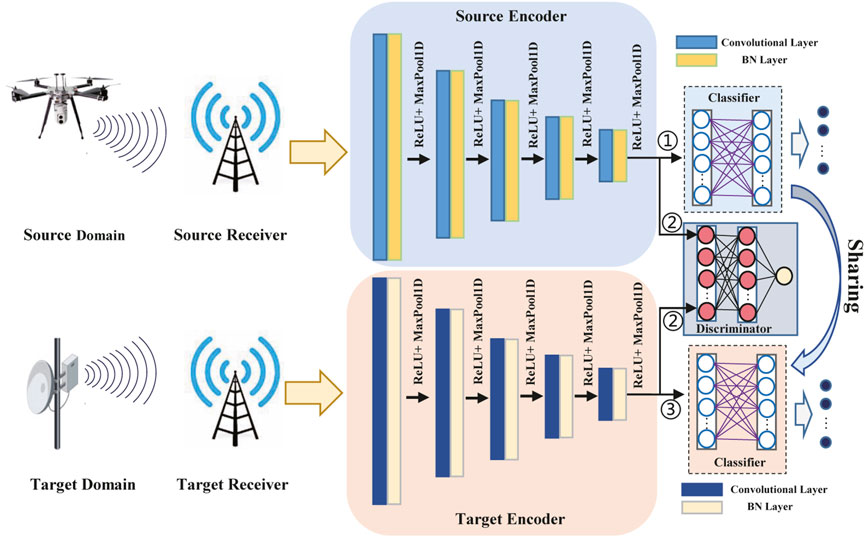
FIGURE 1. Structure of SemiAMR. Source encoder and classifier implement pre-training operation (stage one). Then, source encoder, target encoder, and discriminator realize the domain adaptation stage (stage two). Finally, target encoder and classifier use the predict operation (stage three).
The main implementation process of the proposed SemiAMR approach can be manifested as Algorithm 1. Specifically, Scnn enables a non-linear mapping algorithm for mapping source-domain wireless signal data to the classification domain. For the classification domain, the general classifier
Algorithm 1. Proposed Semi-supervised AMR: SemiAMR
Pretrain
selectrandomly xs ⊂ Xs
fori = 1, …, Ns:
return
Domain adaptation
selectrandomly xs ⊂ Xs, xt ⊂ Dt
fori = 1, …, Nd:
return Tcnn
PREDICT
return Yt
Then, based on the target and source domain data, the discriminator
1) Source encoder Scnn: Scnn extracts key features from the signal data of source domain and then maps the model to the classification domain. Scnn contains five convolutional blocks, and each block consists of a convolutional layer, a batch normalization (BN) layer, an activation function ReLU, and a max-pooling layer. The convolutional layer implements the extraction of useful features, and BN speeds up the training process and convergence of the network by regularizing the data. The activation function ReLU is formulated as fReLU(x) = max(0, x), preventing gradient disappearance and avoiding over-fitting. The max-pooling layer reduces data dimensionality, decreases the number of parameters, removes redundant information, and compresses features.
2) Classifier
3) Target encoder Tcnn: The mapping task is conducted by Tcnn from the target domain data to the classification domain. The structure of Scnn and Tcnn are identical.
4) Discriminator
which can solve the overflow and underflow issues of deep network, speed up operation speed and improve data stability.
As shown in Figure 2, the source encoder and the classifier are combined into an end-to-end model that implements pre-training operations in the first stage. In the second stage, the source encoder, target encoder and discriminator are combined and the discriminator and target encoder are trained with input of source domain data and target domain data, respectively. A number of iterations are performed until the discriminator is unable to determine which domain the data from. In the third stage, the target encoder and the classifier are combined to achieve a complete end-to-end function for the target domain.
4.2 Loss function
In this work, to improve the generation of the CNN-based AMR scheme, Scnn and
where xs denotes the source data, and E(⋅) represents the mathematical expectation operation.
The training strategy of domain adaptation enables data from the target domain to be mapped to the classification domain by Tcnn. In the training process, for data from the source domain (with labels) and data from the target domain (without labels), the discriminator determines whether the incoming data is from the source domain (computed by Scnn) or from the target domain (computed by Tcnn). For each iteration, the network continuously minimizes the loss of the domain discriminator
where xs and xt denote the data of source domain and target domain, respectively. Tcnn signifies the weights of Tcnn are frozen, which means the parameters are not trained, and D represents the frozen parameters of
5 Implementation details
5.1 Datasets and settings
To evaluate the performance of the proposed algorithm, we implement the experiment on the RadioML2016.10a dataset [10]. The details of the dataset and experiment settings are exhibited in Table 2. Accordingly, the modulation of the dataset consists of 8PSK, AM-DSB, AM-SSB, BPSK, CPFSK, GFSK, 4PAM, 16QAM, 64QAM, QPSK, WBFM, with SNR ∈ {−20 dB, 18 dB} and the stride is 2 dB. There are 1,000 pieces of signal data for every SNR of each class, and the total number of data is 220,000. In this way, the dataset is separated into a higher SNR part (source domain), including {2 dB, 4 dB, 6 dB, 8 dB, 10 dB, 12 dB, 14 dB, 16 dB, 18 dB}, and a lower SNR part (target domain) that includes {−20 dB, −18 dB, −16 dB, −14 dB, −12 dB, −10 dB, −8 dB, −6 dB, −4 dB}. In the experiments, an NVIDIA GeForce RTX 2080Ti GPU is employed, and the algorithm is implemented by PyTorch.
5.2 Experiments and discussions
The experimental result of the proposed SemiAMR is exhibited in Figure 3, where “No-Ada” denotes the source encoder inference only, and “Ada” represents the proposed algorithm SemiAMR. Accordingly, for SNR = −8 dB, the classification accuracy of the proposed scheme is 21.6%, which exceeds 11.6% over the baseline “No-Ada”. When SNR = −4 dB, the classification of SemiAMR reaches 41.6%, which far exceeds the no-adaptation method 27.4%, and makes an improvement of 18.6%. The results show that the domain adaptation scheme effectively solves the classification issue of cross signal-to-noise domain.
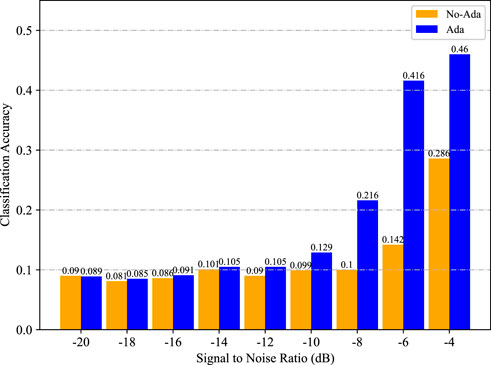
FIGURE 3. Performance comparison of source domain encoder (No-Ada) and domain adaptation (Ada) on target domain data.
Convolutional layers are fundamental building blocks of deep learning models and play a critical role in extracting features from input data. The number of convolutional layers is a crucial factor in the structure of a CNN, and it can significantly impact experimental outcomes. To investigate the impact of different convolutional layers on experimental results, we create an encoder set and measured recognition accuracy at different SNR levels. Table 3 shows that the encoder module with 4 layers achieved a recognition accuracy of 44.3%, while 5 layers achieved 46%, 6 layers reached 46.3%, and 7 layers obtained 45.2%. These results (depicted in Table 3) suggest that the recognition accuracy is not always positively correlated with the number of convolutional layers at every SNR. Interestingly, the recognition accuracy decreases when the number of convolutional layers reaches seven, indicating that the optimal number of convolutional layers is task-dependent and not solely related to increased complexity.
As shown in Figure 4, the normalized confusion matrix of SemiAMR are exhibited, adapting to the target domain under SNR ∈ {−4 dB, −6 dB}. In detail, Figures 4A, C represent that the data of target domain is tested on the Scnn and
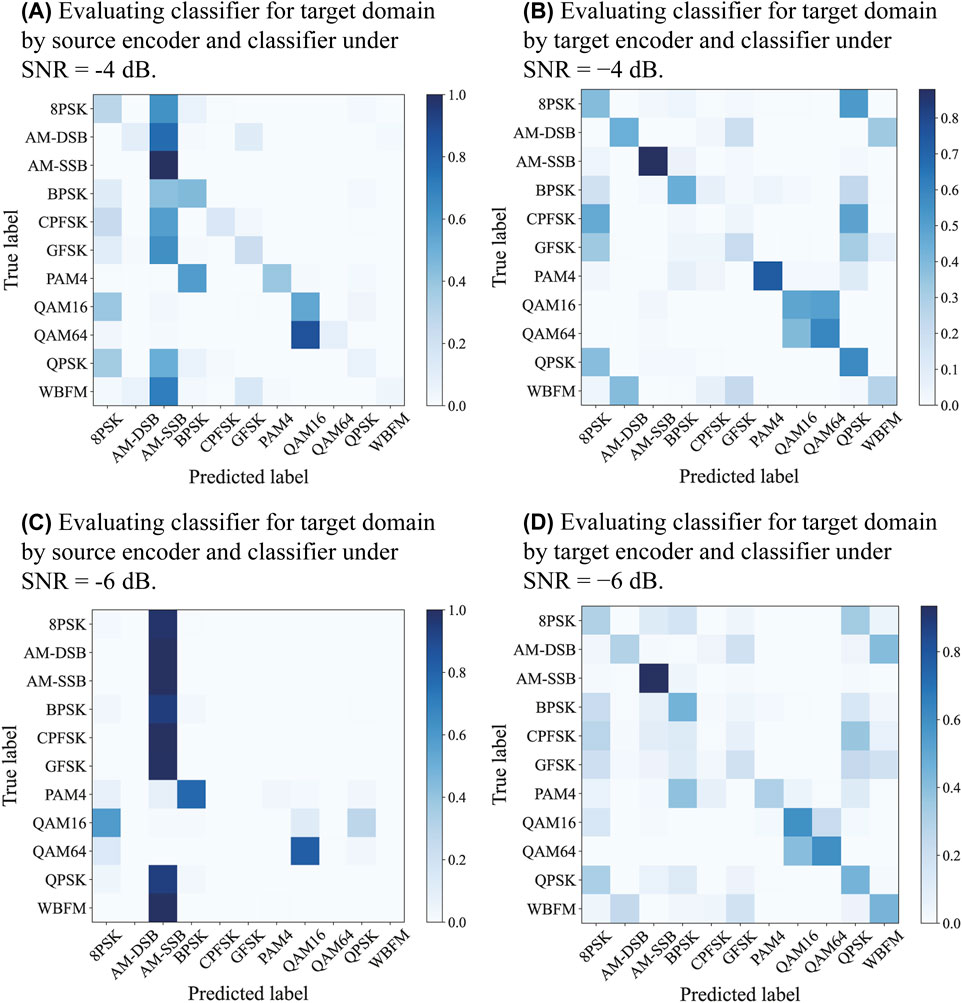
FIGURE 4. Confusion matrix of no-adaptation and adaptation methods when SNR ∈{−6 dB, −4 dB}. (A) Evaluating classifier for target domain by source encoder and classifier under SNR = −4 dB. (B) Evaluating classifier for target domain by target encoder and classifier under SNR = −4 dB. (C) Evaluating classifier for target domain by source encoder and classifier under SNR = −6 dB. (D) Evaluating classifier for target domain by target encoder and classifier under SNR = −6 dB.
The classification performance for various modes is exhibited under the experimental SNRs conditions in Figure 5. From Figure 5, the accuracy of all 11 modulated modes in the target domain increases with SNR. Furthermore, the accuracy of AM-SSB classification is around 90% at each SNR. As CPFSK, 8PSK, and QPSK are easily confused in the classification domain, the classification accuracy of CPFSK does not vary significantly with SNR and is determined into 8PSK and QPSK.
In Figure 6, the recognition accuracy of proposed SemiAMR scheme is compared with various approaches, such as ResNet [11], CLDNN [31], DenseNet [14], SS-VM [32], Proxy-label [33], and FixMatch [34]. In addition, As the SNRs increase from −20 dB to −4 dB, the recognition accuracy of the baseline method gradually increases from 9% to 33%. However, the accuracy of SemiAMR inference starts to exceed that of the baseline method at −12 dB. When SNR = −8 dB, the proposed scheme is higher than the baseline method by about 12%, and at SNR = −6 dB, it is greater than the best classification accuracy of the baseline method by 17%. SemiAMR can reach 47% under SNR = −4 dB, which exceeds the baseline method by 12%. As a result, the accuracy of the no-adapt schemes seems very low in poor signal-to-noise conditions, where labeled signal can not be obtained for pre-training. In terms of proposed SemiAMR scheme, the performance is greatly improved by domain adaptation, yielding a promising inference ability on target domain data as a consequence.
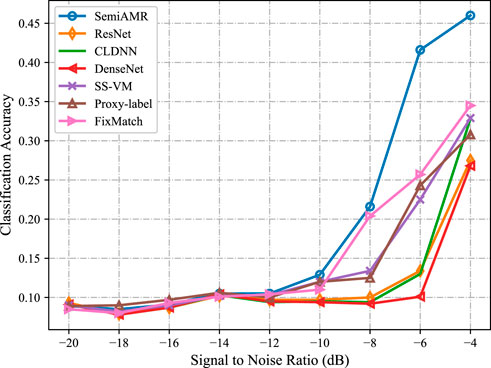
FIGURE 6. Comparison with multiple baseline methods under various SNR conditions in the target domain.
6 Conclusion
In this paper, inspired by the domain adaptation algorithm, we design a semi-supervised architecture for AMR. The proposed scheme is evaluated on the RadioML2016.10a [10], and the adaptability of baseline methods with target domain (unlabeled data) is discussed. Experimental results indicate that our proposed SemiAMR can obtain a maximum classification accuracy of 46% with no corresponding labeled data pre-trained under SNR = −4 dB. Simultaneously, to investigate the effect of the number of convolutional layers on the experimental results, the performance of the model at different signal-to-noise ratios (SNR) was tested with 4, 5, 6 and 7 convolutional layers. Besides, the proposed SemiAMR is greater than the best classification accuracy of the baseline methods by 17% under SNR = −6 dB.
Data availability statement
The original contributions presented in the study are included in the article/Supplementary Material, further inquiries can be directed to the corresponding author.
Author contributions
QZ was in charge of the major theoretical analysis, algorithm design, experimental simulation, and paper writing. XJ and QZ had contributions to paper writing. ZJ and RZ had contributions to theoretical analysis and gave suggestions of the organization. All authors read and approved the final manuscript.
Funding
This work is supported by BUPT Excellent Ph.D. Students Foundation (Grant No. CX2022302).
Conflict of interest
The authors declare that the research was conducted in the absence of any commercial or financial relationships that could be construed as a potential conflict of interest.
Publisher’s note
All claims expressed in this article are solely those of the authors and do not necessarily represent those of their affiliated organizations, or those of the publisher, the editors and the reviewers. Any product that may be evaluated in this article, or claim that may be made by its manufacturer, is not guaranteed or endorsed by the publisher.
References
1. Chu Z, Xiao P, Mi D, Hao W, Lin Z, Chen Q, et al. Wireless-powered intelligent radio environment with nonlinear energy harvesting. IEEE Internet Things J (2022) 9(18):18130–41. doi:10.1109/JIOT.2022.3162761
2. Du H, Deng Y, Xue J, Meng D, Zhao Q, Xu Z. Robust online CSI estimation in a complex environment. IEEE Trans Wireless Commun (2022) 21(10):8322–36. doi:10.1109/TWC.2022.3165588
3. Upadhyaya P, Dutt S, Ruchi, Upadhyaya S. 6G communication: Next generation technology for IoT applications. In: Proceeding of the 2021 First International Conference on Advances in Computing and Future Communication Technologies (ICACFCT); December 2021; Meerut, India. IEEE (2021). p. 23–6. doi:10.1109/ICACFCT53978.2021.9837375
4. Mu J, Jing X, Zhang Y, Gong Y, Zhang R, Zhang F. Machine learning-based 5G RAN slicing for broadcasting services. IEEE Trans Broadcast (2022) 68(2):295–304. doi:10.1109/TBC.2021.3122353
5. Zhang R, Jiang C, Wu S, Zhou Q, Jing X, Mu J. Wi-fi sensing for joint gesture recognition and human identification from few samples in human-computer interaction. IEEE J Sel Areas Commun (2022) 40(7):2193–205. doi:10.1109/JSAC.2022.3155526
6. Jdid B, Hassan K, Dayoub I, Lim WH, Mokayef M. Machine learning based automatic modulation recognition for wireless communications: A comprehensive survey. IEEE Access (2021) 9:57851–73. doi:10.1109/ACCESS.2021.3071801
7. Wang F, Dobre OA, Chan C, Zhang J. Fold-based KolmogorovSmirnov modulation classifier. IEEE Signal Process Lett (2016) 23(7):1003–7. doi:10.1109/lsp.2016.2572666
8. Chen W, Xie Z, Ma L, Liu J, Liang X. A faster maximum likelihood modulation classification in flat fading non-Gaussian channels. IEEE Commun Lett (2019) 23(3):454–7. doi:10.1109/lcomm.2019.2894400
9. Kharbech S, Dayoub I, Zwingelstein-Colin M, Simon EP. On classifiers for blind feature-based automatic modulation classification over multiple-input-multiple-output channels. IET Commun (2016) 10(7):790–5. doi:10.1049/iet-com.2015.1124
10. O’ Shea TJ, West N. Radio machine learning dataset generation with GNU radio. In: Proc. of the GNU Radio Conf.; September 2016; Boulder, CO, USA (2016). p. 1–6.
11. O’ Shea TJ, Roy T, Clancy TC. Over-the-air deep learning basedradio signal classification. IEEE J Sel Top Signal Process. (2018) 12(1):168–79. doi:10.1109/jstsp.2018.2797022
12. Zhang Z, Luo H, Wang C, Gan C, Xiang Y. Automatic modulation classification using CNN-lstm based dual-stream structure. IEEE Trans Veh Technol (2020) 69(11):13521–31. doi:10.1109/TVT.2020.3030018
13. Huang S, Jiang Y, Gao Y, Feng Z, Zhang P. Automatic modulation classification using contrastive fully convolutional network. IEEE Wirel Commun Lett (2019) 8(4):1044–7. doi:10.1109/LWC.2019.2904956
14. Dileep P, Das D, Bora PK. Dense layer dropout based CNN architecture for automatic modulation classification. In: Proceeding of the 2020 National Conference on Communications (NCC); February 2020; Kharagpur, India. IEEE (2020). p. 1–5. doi:10.1109/NCC48643.2020.9055989
15. Bu K, He Y, Jing X, Han J. Adversarial transfer learning for deep learning based automatic modulation classification. IEEE Signal Process Lett (2020) 27:880–4. doi:10.1109/LSP.2020.2991875
16. Li L, Huang J, Cheng Q, Meng H, Han Z. Automatic modulation recognition: A few-shot learning method based on the capsule network. IEEE Wirel Commun Lett (2021) 10(3):474–7. doi:10.1109/LWC.2020.3034913
17. Yang J, Peng Y, Zhou Y, Liu L, Qi Y. SNR-Aware automatic modulation recognition based on modified deep residual networks. In: Proceeding of the 2022 IEEE 95th Vehicular Technology Conference: (VTC2022-Spring); June 2022; Helsinki, Finland. IEEE (2022). p. 1–5. doi:10.1109/VTC2022-Spring54318.2022.9860547
18. Jia X, Jing XY, Zhu X, Chen S, Du B, Cai Z, et al. Semi-supervised multi-view deep discriminant representation learning. IEEE Trans Pattern Anal Mach Intell (2021) 43(7):2496–509. doi:10.1109/TPAMI.2020.2973634
19. Song Z, Yang X, Xu Z, King I. Graph-based semi-supervised learning: A comprehensive review. IEEE Trans Neural Netw Learn Syst (2022). doi:10.1109/TNNLS.2022.3155478
20. Li C, Zhu J, Zhang B. Max-margin deep generative models for (Semi-)Supervised learning. IEEE Trans Pattern Anal Mach Intell (2018) 40(11):2762–75. doi:10.1109/TPAMI.2017.2766142
21. Ai Q, Kang Y, Wang A, Li X, Li F. An effective semi-supervised multi-label least squares twin support vector machine. IEEE Access (2020) 8:213460–72. doi:10.1109/ACCESS.2020.3040199
22. Wang Y, Gui G, Gacanin H, Ohtsuki T, Sari H, Adachi F. Transfer learning for semi-supervised automatic modulation classification in ZF-MIMO systems. IEEE Jour Emer Select Top Circu Syste (2020) 10(2):231–9. doi:10.1109/JETCAS.2020.2992128
23. Mu J, Zhang R, Cui Y, Gao N, Jing X. UAV meets integrated sensing and communication: Challenges and future directions. IEEE Commun Mag (2023). doi:10.1109/MCOM.008.2200510
24. Mu J, Ouyang W, Jing Z, Li B, Zhang F. Energy-efficient interference cancellation in integrated sensing and communication scenarios. IEEE Trans Green Commun Netw (2023) 7(1):370–8. doi:10.1109/TGCN.2023.3234404
25. Wang Y, Liu M, Yang J, Gui G. Data-driven deep learning for automatic modulation recognition in cognitive radios. IEEE Trans Veh Technol (2019) 68(4):4074–7. doi:10.1109/TVT.2019.2900460
26. Li J, Meng Q, Zhang G, Sun Y, Qiu L, Ma W. Automatic modulation classification using support vector machines and error correcting output codes. In: Proceeding of the 2017 IEEE 2nd Information Technology, Networking, Electronic and Automation Control Conference (ITNEC); December 2017; Chengdu, China. IEEE (2017). p. 60–3. doi:10.1109/ITNEC.2017.8284863
27. Jagannath J, Polosky N, O'Connor D, Theagarajan LN, Sheaffer B, Foulke S, et al. Artificial neural network based automatic modulation classification over a software defined radio testbed. In: Proceeding of the 2018 IEEE International Conference on Communications (ICC); May 2018; Kansas City, MO, USA. IEEE (2018). p. 1–6. doi:10.1109/ICC.2018.8422346
28. Triantafyllakis K, Surligas M, Vardakis G, Papadakis S. Phasma: An automatic modulation classification system based on Random Forest. In: Proceeding of the 2017 IEEE International Symposium on Dynamic Spectrum Access Networks (DySPAN); March 2017; Baltimore, MD, USA. IEEE (2017). p. 1–3. doi:10.1109/DySPAN.2017.7920749
29. Yang H, Zhao L, Yue G, Ma B, Li W. IRLNet: A short-time and robust architecture for automatic modulation recognition. IEEE Access (2021) 9:143661–76. doi:10.1109/ACCESS.2021.3121762
30. Zhang Z, Liu F, Sheng J, Huang C, Shi B. Index modulation recognition based on projection residual analysis. IEEE Trans Cogn Commun Netw (2022) 8(3):1387–98. doi:10.1109/TCCN.2022.3173670
31. Emam A, Shalaby M, Aboelazm MA, Bakr HEA, Mansour HAA. A comparative study between CNN, LSTM, and CLDNN models in the context of radio modulation classification. In: Proceeding of the 2020 12th International Conference on Electrical Engineering (ICEENG); July 2020; Cairo, Egypt. IEEE (2020). p. 190–5. doi:10.1109/ICEENG45378.2020.9171706
32. Bennett K, Demiriz A. Semi-supervised support vector machines. In: Adv neural inf proces syst (1998). p. 368–74.
33. Rizve MN, Duarte K, Rawat YS, Shah M. In defense of pseudo-labeling: An uncertainty-aware pseudo-label selection framework for semi-supervised learning (2021). arXiv:2101.06329. doi:10.48550/arXiv.2101.06329
Keywords: automatic modulation classification, wireless IoT, semi-supervised learning, domain adaptation, convolutional neural network
Citation: Zhou Q, Zhang R, Jing Z and Jing X (2023) Semi-supervised-based automatic modulation classification with domain adaptation for wireless IoT spectrum monitoring. Front. Phys. 11:1158577. doi: 10.3389/fphy.2023.1158577
Received: 04 February 2023; Accepted: 16 March 2023;
Published: 31 March 2023.
Edited by:
Michel Kadoch, École de technologie supérieure (ÉTS), CanadaReviewed by:
Meet Kumari, Chandigarh University, IndiaYongkang Gong, Queen Mary University of London, United Kingdom
Copyright © 2023 Zhou, Zhang, Jing and Jing. This is an open-access article distributed under the terms of the Creative Commons Attribution License (CC BY). The use, distribution or reproduction in other forums is permitted, provided the original author(s) and the copyright owner(s) are credited and that the original publication in this journal is cited, in accordance with accepted academic practice. No use, distribution or reproduction is permitted which does not comply with these terms.
*Correspondence: Zexuan Jing, amluZ3p4QGJ1cHQuZWR1LmNu
 Quan Zhou
Quan Zhou Ronghui Zhang
Ronghui Zhang